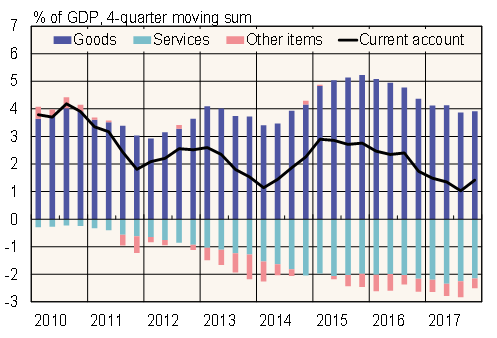BOFIT Weekly Review 07/2018
China's current account surplus fell to 1.4 % of GDP last year
Preliminary balance-of-payments figures from the People's Bank of China show that the goods trade surplus fell slightly last year from 2016 to a level of 476 billion dollars, while the services trade deficit increased to 261 billion dollars. The total current account surplus fell from 196 billion dollars in 2016 to 172 billion dollars last year (1.4 % of GDP).
China's large services trade deficit reflects trends in tourism. While Chinese tourist spending abroad last year (tourism imports) did not increase, foreign tourists visiting China declined slightly (tourism exports). Thus, the tourism deficit rose to 221 billion dollars. The rest of the services trade deficit was explained by a 56 billion-dollar deficit in transport services. While other services trade categories are small, they were overall in surplus.
The flow of direct investment shown on the financial account turned positive again, i.e. more investment flowed into China (USD 165 billion) than out of the country (USD 101 billion). The change reflected China's implementation of stricter limits on capital exports. The flow of direct investment turned negative for the first time in 2016.
China's foreign exchange reserves started to increase again last year. The balance-of-payments figures show the rise in currency reserves was USD 92 billion. In the national accounts, currency reserves last year were up USD 138 billion indicating that a third of the value increase in reserves came from exchange rates and other valuation changes. The value of currency reserves in January (incl. gold, SDRs and IMF reserve funds) rose by USD 25 billion to USD 3.261 trillion.
China customs data show that January's trade surplus was just USD 20 billion as the value of goods imports rose to USD 180 billion. The value of goods exports was USD 201 billion. The timing of the Chinese Lunar New Year holiday impacts January and February economic figures. This year, the week-long celebrations began February 15.
Trends of China's current account components and GDP

Sources: Macrobond, BOFIT.